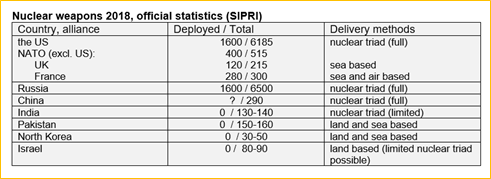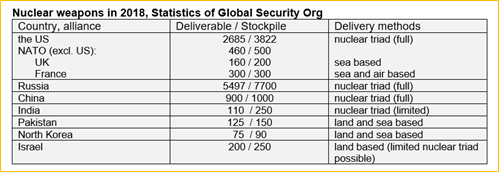Nuclear weapons

Other views are also available regarding nuclear weapons (e.g. Global Security org, FAS).

Today strategic parity is almost impossible to exactly define and count regarding nuclear weapons. In the 1970s and 1980s there was a reasonably clear distinction between strategic nuclear weapons and everything else, so ensuring parity was relatively simple.
Basically, the US and the USSR settled on numbers of missiles, long-range bombers, submarines and warheads they were comfortable with and agreed ways to verify that each party sticks to the limits. In this context, the term Mutually Assured Destruction (MAD) was coined, referring to the capacity of nuclear-armed powers to obliterate each other in a nuclear exchange. Therefore, such an exchange would not benefit either party, since it would only bring about a nuclear winter from which no winner could emerge.
The distinction between nuclear and non-nuclear, conventional and non-conventional is blurred today. In addition, today increasing use of so-called proxy warriors by all great powers is apt to confuse the picture even more.
However, some kind of a balance between great powers is necessary in order to avoid nuclear war to happen. An armed conflict involving nuclear-capable powers has the increasing potential to spiral out of control, with sides trading progressively serious blows and hoping the other one will chicken out.
A few decades ago, the fear of nuclear weapons put a reasonably low cap on such games of nerves, but it is no longer the case and the risks are rising by the year.


